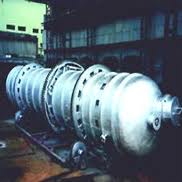Difference between revisions of "Conduction Dryers"
(Created page with "Category:Drying{{Knoppen}} <noinclude><!------------------------------------------------ * READ THIS FIRST * Only edit this page if you can improve the content. * Imprope...") |
|||
| Line 5: | Line 5: | ||
* Please start editing this page after the /noinclude | * Please start editing this page after the /noinclude | ||
* -------------------------------------------------></noinclude> | * -------------------------------------------------></noinclude> | ||
[[File:Conduction_Dryers.jpg|thumb|200px|right|Conduction Dryers]] | |||
The '''Conduction Dryers''' employ the conduction mode for drying. These dryers ensure low temperature, gentle drying of the product. Conduction dryers are designed taking into consideration the wet and dry product flow characteristics, lump crust formation tendency and thermal sensitivity of the product in dry condition. | |||
A continuous conduction dryer can dry heat-sensitive solutions, slurries, pastes, and granules containing pigments, gypsum, clays, fine chemicals, fine coal, and salts and can be used for relatively short retention times. The dryer conveys as well as dries material; controlling the conveying speed controls the retention time. The continuous conduction dryer requires no material-handling labor, making its operating cost typically much lower than that of a batch unit. | |||
Latest revision as of 10:00, 27 July 2012
The Conduction Dryers employ the conduction mode for drying. These dryers ensure low temperature, gentle drying of the product. Conduction dryers are designed taking into consideration the wet and dry product flow characteristics, lump crust formation tendency and thermal sensitivity of the product in dry condition. A continuous conduction dryer can dry heat-sensitive solutions, slurries, pastes, and granules containing pigments, gypsum, clays, fine chemicals, fine coal, and salts and can be used for relatively short retention times. The dryer conveys as well as dries material; controlling the conveying speed controls the retention time. The continuous conduction dryer requires no material-handling labor, making its operating cost typically much lower than that of a batch unit.
